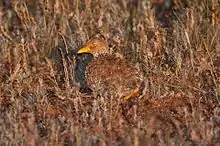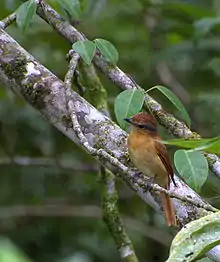List of birds
This page lists living orders and families of birds. The links below should then lead to family accounts and hence to individual species.
.jpg.webp)

The passerines (perching birds) alone account for well over 5,000 species. In total there are about 10,000 species of birds described worldwide, though one estimate of the real number places it at almost twice that.[1]
Taxonomy is very fluid in the age of DNA analysis, so comments are made where appropriate, and all numbers are approximate. In particular see Sibley-Ahlquist taxonomy for a very different classification.
Phylogeny
Cladogram of modern bird relationships based on Jarvis, E.D. et al. (2014)[2] with some clade names after Yuri, T. et al. (2013).[3]
Paleognathae
The Paleognathae, or "old jaws", are one of the two superorders recognized within the taxonomic class Aves and consist of the ratites and tinamous. The ratites are mostly large and long-legged, flightless birds, lacking a keeled sternum. Traditionally, all the ratites were place in the order Struthioniformes. However, recent genetic analysis has found that the group is not monophyletic, as it is paraphyletic with respect to the tinamous, so the ostriches are classified as the only members of the order Struthioniformes and other rattites placed in other orders.[6][7]
Dinornithiformes
New Zealand
- †Megalapteryidae: upland moas
- †Dinornithidae: great moas
- †Emeidae: lesser moas
Neognathae
Nearly all living birds belong to the superorder Neognathae or "new jaws". With their keeled sternum (breastbone), unlike the ratites, they are known as carinatae.
Galliformes

Worldwide; 250 species
- †Sylviornithidae
- Megapodii
- Megapodidae: megapodes
- Craci
- Cracidae: chachalacas, curassows, and guans
- Phasiani
- Numidioidea
- Numididae: guineafowl
- Phasianoidea: pheasants and allies
- Odontophoridae: New World quail
- Phasianidae: pheasants and relatives
- Numidioidea
Gastornithiformes
- †Gastornithidae
- †Dromornithidae: mihirungs
Anseriformes
Worldwide; 150 species
Phoenicopteriformes
Worldwide; 6 species
- †Palaelodidae: swimming flamingos
- Phoenicopteridae: flamingos
Caprimulgiformes
Worldwide; 500 species
_2.jpg.webp)
- Caprimulgidae: nightjars
- Steatornithidae: oilbird
- Nyctibiidae: potoos
- Podargidae: frogmouths
- Daedalornithes
- Aegothelidae: owlet-nightjars
- Hemiprocnidae: treeswifts
- Apodidae: swifts
- Trochilidae: hummingbirds
Gruiformes
Worldwide; 164 species
- Grui: cranes and allies
- Gruidae: cranes
- Aramidae: limpkin
- Psophiidae: trumpeters
- Ralli: rails and allies
- †Aptornithidae: adzebills
- Heliornithidae: finfoots
- Sarothruridae: flufftails
- Rallidae: rails and relatives
Charadriiformes
Worldwide; 350 species
- Charadrii
- Chionida: thick-knees and allies
- Burhinidae: thick-knees and relatives
- Chionididae: sheathbills
- Pluvianellidae: Magellanic plover
- Charadriida: plover-like waders
- Pluvialidae: golden plovers
- Ibidorhynchidae: ibisbill
- Haematopodidae: oystercatchers
- Recurvirostridae: avocets and stilts
- Charadriidae: plovers and lapwings
- Chionida: thick-knees and allies
- Scolopaci
- Jacanida: jacana-like waders
- Rostratulidae: painted snipes
.jpg.webp) Greater painted-snipe
Greater painted-snipe - Pluvianidae: Egyptian plover
.jpg.webp) Egyptian plover
Egyptian plover - Jacanidae: jacanas
- Thinocoridae: seedsnipes
- Pedionomidae: plains-wanderer
 Plains-wanderer
Plains-wanderer
- Scolopacida
- Scolopacidae: sandpipers and relatives
- Jacanida: jacana-like waders
- Lari
- Turnicida
- Turnicidae: buttonquail
- Larida: gulls and allies
- Glareolidae: coursers and pratincoles
- Dromadidae: crab-plover
- Stercorariidae: skuas and jaegers
- Alcidae: auks and puffins
- Laridae: gulls, skimmers and terns
- Turnicida
Eurypygiformes
Neotropics and New Caledonia; 2 species
- Rhynochetidae: kagu
- Eurypygidae: sunbittern
.JPG.webp) Sunbittern
Sunbittern
Procellariiformes
Pan-oceanic; 120 species
- Diomedeidae: albatrosses
- Oceanitidae: austral storm petrels
- Hydrobatidae: northern storm petrels
- Procellariidae: petrels and relatives
Suliformes
Worldwide; 59 species
- Fregatae
- Fregatidae: frigatebirds
- Sulae
- Sulidae: boobies and gannets
- Anhingidae: darters
- Phalacrocoracidae: cormorants and shags
Pelecaniformes
_about_to_eat_a_fish.jpg.webp)
Worldwide; 108 species
- Threskiornithes
- Pelecani
- Scopidae: hamerkop
- Balaenicipitidae: shoebill
- Pelecanidae: pelicans
- Ardeae
- Ardeidae: herons and relatives
Accipitriformes

Worldwide; 200 species
- Cathartae
- Cathartidae: New World vultures
- Accipitres
- Sagittariidae: secretarybird
- Pandionidae: osprey
- Accipitridae: hawks, eagles, buzzards, harriers, kites and Old World vultures
Bucerotiformes
Old World, New Guinea; 64 species
- Buceroidea
- Bucerotidae: hornbills
- Upupoidea
- Upupidae: hoopoe
- Phoeniculidae: woodhoopoes
Coraciiformes
Worldwide; 144 species
- Meropi
- Meropidae: bee-eaters
- Coracii
- Coraciidae: rollers
- Brachypteraciidae: ground rollers
- Coracii
- Todidae: todies
- Momotidae: motmots
- Alcedinidae: kingfishers
_in_Hyderabad_W_IMG_8523.jpg.webp)
Piciformes
Worldwide except Australasia; 400 species
- Galbuli
- Galbulidae: jacamars
- Bucconidae: puffbirds
- Pici
- Lybiidae: African barbets
- Megalaimidae: Asian barbets
- Ramphastidae: toucans
- Semnornithidae: toucan barbets
- Capitonidae: American barbets
- Picidae: woodpeckers
- Indicatoridae: honeyguides
Psittaciformes
Pan-tropical, southern temperate zones; 330 species
- Strigopoidea
- Strigopidae: kakapo, kea and kakas
- Cacatuoidea
- Cacatuidae: cockatoos
- Psittacoidea
- Psittacidae: African and American parrots
- Psittaculidae: Australasian parrots, Pesquet's parrot, vasa parrots
Passeriformes

Worldwide; 5,000 species
- Acanthisitti
- Acanthisittidae: New Zealand wrens
- Tyranni: suboscines
- Eurylaimides: Old World suboscines
- Sapayoidae: sapayoa
- Calyptomenidae: Calyptomenid broadbills
- Pittidae: pittas
- Eurylaimidae: broadbills
- Philepittidae: asities
- Tyrannides: New World suboscines
- Tyrannida: bronchophones
- Pipridae: manakins
- Cotingidae: cotingas
- Oxyruncidae: sharpbills
- Onychorhynchidae: royal flycatchers and allies
- Tityridae: becards and tityras
- Pipritidae: pipriteses
- Platyrinchidae: spadebills
- Tachurididae: many-colored rush tyrants
- Rhynchocyclidae: mionectine flycatchers
- Tyrannidae: tyrant flycatchers
- Furnariida: tracheophones
- Melanopareiidae: crescent-chests
- Conopophagidae: gnateaters
- Thamnophilidae: antbirds
- Grallariidae: antpittas
- Rhinocryptidae tapaculos
- Formicariidae: ground antbirds
- Furnariidae: ovenbirds
- Tyrannida: bronchophones
- Eurylaimides: Old World suboscines
- Passeri: oscines
- Menurides
- Atrichornithidae: scrub-birds
- Menuridae: lyrebirds
- Climacterides
- Ptilonorhynchidae: bowerbirds
- Climacteridae: Australasian treecreepers
- Meliphagides
- Maluridae: Australasian wrens
- Dasyornithidae: bristlebirds
- Pardalotidae: gerygones and allies (Acanthizidae)
- Meliphagidae: honeyeaters and relatives
- Orthonychides
- Pomatostomidae: Australasian babblers
- Orthonychidae: logrunners
- Corvides
- Cinclosomatoidea
- Cinclosomatidae: quail-thrushes and jewel-babblers
- Campephagoidea
- Campephagidae: cuckoo-shrikes
- Mohouoidea
- Mohouidae: whitehead and allies
- Neosittoidea
- Neosittidae: sittellas
- Orioloidea
- Eulacestomidae: wattled ploughbills
- Psophodidae: whipbirds and quail-thrushes
- Oreoicidae: Australo-Papuan bellbirds
- Falcunculidae: crested shriketits
- Paramythiidae: painted berrypeckers
- Pteruthiidae: shrike-babblers
- Vireonidae: vireos and relatives
- Pachycephalidae: whistlers and relatives (Colluricinclidae)
- Oriolidae: Old World orioles
- Malaconotoidea
- Machaerirhynchidae: boatbills
- Artamidae: woodswallows and butcherbirds
- Rhagologidae: mottled berryhunter
- Aegithinidae: ioras
- Pityriaseidae: bristlehead
- Malaconotidae: bushshrikes and relatives
- Platysteiridae: wattle-eyes and batises
- Vangidae: vangas (Tephrodornithidae; Prionopidae)
- Corvoidea
- Rhipiduridae: fantails
- Lamproliidae: silktail, drongo fantail
- Dicruridae: drongos
- Ifritidae: blue-capped ifrits
- Melampittidae: melampittas
- Corcoracidae: Australian mudnesters
- Paradisaeidae: birds-of-paradise
- Monarchidae: monarch flycatchers
- Laniidae: shrikes
- Corvidae: jays and crows
- Cinclosomatoidea
- Passerides
- Melanocharitida
- Melanocharitidae: berrypeckers
- Cnemophilida
- Cnemophilidae: satinbirds
- Petroicida
- Petroicidae: Australasian robins
- Notiomystidae: stitchbird
- Callaeidae: wattlebirds
- Eupetida
- Picathartidae: rockfowl
- Chaetopidae: rock-jumpers
- Eupetidae: rail-babbler
- Sylviida
- Paroidea
- Stenostiridae: fairy warblers
- Hyliotidae: hyliotas
- Remizidae: penduline tits
- Paridae: chickadees and true tits
- Alaudoidea
- Nicatoridae: nicators
- Panuridae: bearded reedling
- Alaudidae: larks
- Macrosphenidae: African warblers
- Locustelloidea
- Cisticolidae: cisticolas and relatives
- Acrocephalidae: marsh warblers
- Pnoepygidae: pygmy wren-babblers
- Locustellidae: grass warblers
- Donacobiidae: donacobius
- Bernieridae: Malagasy warblers
- Hirundinidae: swallows and martins
- Pycnonotidae: bulbuls
- Aegithaloidea
- Phylloscopidae: leaf warblers
- Cettiidae: bush warblers (Erythrocercidae; Scotocercidae)
- Hyliidae: hylias
- Aegithalidae: bushtits
- Sylvioidea
- Sylviidae: true warblers
- Paradoxornithidae: parrotbills, fulvettas
- Zosteropidae: white-eyes
- Timaliidae: babblers and relatives
- Pellorneidae: fulvettas, ground babblers
- Leiothrichidae: laughing thrushes
- Paroidea
- Muscicapida
- Reguloidea
- Regulidae: kinglets
- Bombycilloidea
- Elachuridae: spotted wren-babblers
- †Mohoidae: Hawaiian honeyeaters
- Ptiliogonatidae: silky-flycatchers
- Bombycillidae: waxwings
- Dulidae: palmchat
- Hypocoliidae: hypocolius
- Certhioidea
- Tichodromidae: wallcreeper
- Sittidae: nuthatches
- Certhiidae: treecreepers
- Troglodytidae: wrens
- Polioptilidae: gnatcatchers
- Muscicapoidea
- Cinclidae: dippers
- Turdidae: thrushes and relatives
- Muscicapidae: flycatchers and relatives
- Buphagidae: oxpeckers
- Mimidae: mockingbirds and thrashers
- Sturnidae: starlings and mynas (Rhabdornithidae)
- Reguloidea
- Passerida
- Promeropidae: sugarbirds
- Arcanatoridae: dapplethroat and allies
- Dicaeidae: flowerpeckers
- Nectariniidae: sunbirds
- Irenidae: fairy-bluebirds
- Chloropseidae: leafbirds
- Peucedramidae: olive warbler
- Prunellidae: accentors
- Ploceoidea
- Urocynchramidae: pink-tailed bunting
- Ploceidae: weavers and relatives
- Viduidae: whydahs and indigobirds
- Estrildidae: weaver finches
- Passerid clade
- Passeridae: Old World sparrows
- Motacillidae: wagtails and pipits
- Fringillidae: finches and relatives
- Calcariidae: longspurs, snow buntings
- Rhodinocichlidae: rosy thrush-tanagers
- Emberizidae: Old World buntings and New World sparrows
- Passerellidae: American sparrows
- Phaenicophilidae: palm-tanager and allies
- Icteridae: New World blackbirds and New World orioles
- Teretistridae: Cuban warblers
- Parulidae: wood warblers
- Mitrospingidae
- Cardinalidae: cardinals, grosbeaks, and New World buntings
- Thraupidae: tanagers and relatives (Coerebidae)
- Melanocharitida
- Menurides
See also
- Lists of animals
- List of chicken breeds
- List of birds by common name
- List of individual birds
- Lists by continent
- Lists by smaller geographic unit
- Extinct birds
- List of fictional birds
References
- Barrowclough, GF; Cracraft, J; Klicka, J; Zink, RM (2016). "How Many Kinds of Birds Are There and Why Does It Matter?". PLoS ONE. 11 (11): e0166307. doi:10.1371/journal.pone.0166307.
- Jarvis, E.D.; et al. (2014). "Whole-genome analyses resolve early branches in the tree of life of modern birds". Science. 346 (6215): 1320–1331. doi:10.1126/science.1253451. PMC 4405904. PMID 25504713.
- Yuri, T.; et al. (2013). "Parsimony and Model-Based Analyses of Indels in Avian Nuclear Genes Reveal Congruent and Incongruent Phylogenetic Signals". Biology. 2 (1): 419–444. doi:10.3390/biology2010419. PMC 4009869. PMID 24832669.
- Boyd, John (2007). "NEORNITHES: 46 Orders" (PDF). John Boyd's website. Retrieved 30 December 2017.
- Worthy, T.H.; Degrange, F.J.; Handley, W.D.; Lee, M.S.Y. (2017). "The evolution of giant flightless birds and novel phylogenetic relationships for extinct fowl (Aves, Galloanseres)". Royal Society Open Science. 11: 170975. doi:10.1098/rsos.170975.
- Hackett, S.J.; et al. (2008). "A Phylogenomic Study of Birds Reveals Their Evolutionary History". Science. 320: 1763. doi:10.1126/science.1157704.
- Yuri, T (2013). "Parsimony and model-based analyses of indels in avian nuclear genes reveal congruent and incongruent phylogenetic signals". Biology. 2: 419–44. doi:10.3390/biology2010419. PMC 4009869. PMID 24832669.







